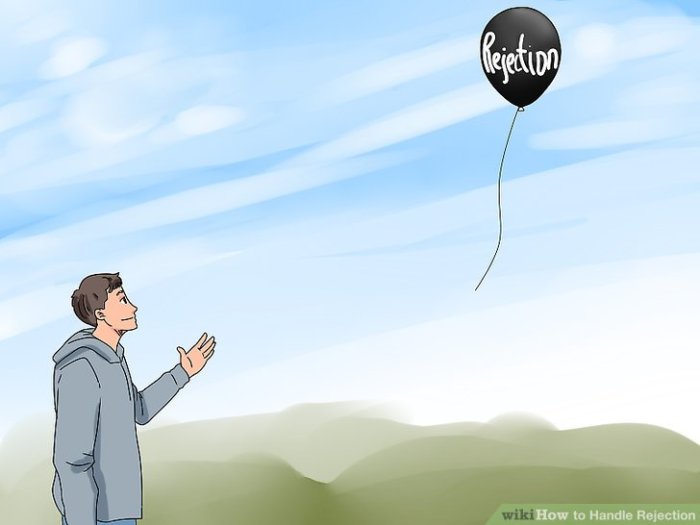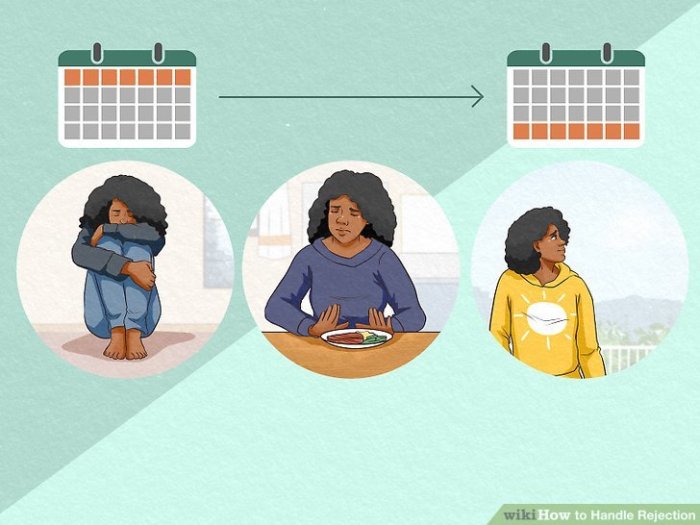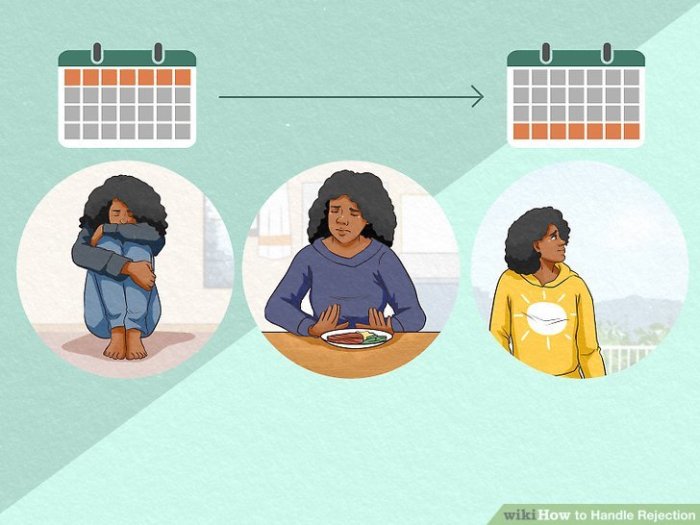How to handle rejection is a crucial life skill. Rejection, in its many forms – romantic, professional, or social – is a universal experience. Understanding the various types of rejection, the emotional responses, and the root causes is the first step to navigating these difficult situations with grace and resilience.
This guide explores the complexities of rejection, offering insights into identifying the root causes, developing healthy coping mechanisms, and ultimately reframing rejection as an opportunity for growth. We’ll delve into practical strategies for handling rejection in specific contexts, from romantic relationships to professional settings and social interactions. By understanding the impact of past experiences and societal pressures, you can gain a deeper understanding of your own responses and learn how to build resilience.
Understanding Rejection
Rejection is a universal human experience, impacting us in various aspects of life. Whether it’s a romantic pursuit, a job application, or a social interaction, the sting of rejection can be significant. Understanding the nuances of rejection, from its different forms to the emotional responses and cognitive biases involved, is crucial in navigating these challenging moments and fostering resilience.This exploration delves into the complex landscape of rejection, examining its multifaceted nature and the psychological impact it has on individuals.
We’ll uncover the different types of rejection, the range of emotional responses, and how past experiences and societal pressures shape our perception of these experiences. By understanding these elements, we can develop more effective coping mechanisms and build greater emotional intelligence.
Forms of Rejection
Rejection manifests in various ways, influencing different areas of our lives. Romantic rejection, for instance, involves the denial of a desired romantic relationship. Professional rejection can encompass the refusal of a job opportunity, a promotion, or a crucial project. Social rejection, on the other hand, involves being excluded from a group or facing negative social interactions.
Emotional Responses to Rejection
Rejection elicits a spectrum of emotional responses. Common feelings include hurt, disappointment, and anger. The intensity of these emotions varies depending on the context and the individual’s personality and past experiences. A sense of inadequacy, shame, or a lowered self-esteem can also be present. Understanding the specific emotional response to rejection is crucial for developing appropriate coping strategies.
Impact of Past Rejection Experiences
Past experiences of rejection profoundly influence our current responses. Repeated rejections can lead to a heightened sensitivity to future potential rejections. Individuals who have experienced significant rejection in the past may develop negative self-beliefs, impacting their confidence and self-worth. This can manifest in a fear of failure, leading to avoidance behaviours.
Cognitive Biases in Perceiving Rejection
Cognitive biases can distort our perception of rejection. For instance, the confirmation bias might lead individuals to selectively focus on negative feedback while ignoring positive aspects. The fundamental attribution error can cause individuals to attribute rejection to personal flaws rather than external factors. These biases significantly influence how we interpret and react to rejection.
Societal Pressures and Expectations
Societal pressures and expectations play a significant role in shaping our feelings about rejection. In some cultures, there’s a strong emphasis on achievement and success, leading to increased anxiety and fear of failure. The pressure to conform to societal standards can make rejection feel even more devastating.
Contrast of Rejection Types and Emotional Responses
| Type of Rejection | Common Emotional Responses |
|---|---|
| Romantic Rejection | Hurt, sadness, disappointment, anger, insecurity, fear of intimacy, self-doubt. |
| Professional Rejection | Disappointment, frustration, self-criticism, anger, fear of failure, anxiety about future opportunities. |
| Social Rejection | Loneliness, isolation, hurt feelings, shame, anxiety, difficulty trusting others. |
Identifying the Root Cause of Rejection
Rejection, while painful, can be a valuable learning experience. Understandingwhy* you were rejected is crucial for personal growth and future success. By analyzing the situation objectively, we can identify patterns and develop strategies to navigate future opportunities. This process requires self-reflection and an honest assessment of both internal and external factors.Identifying the root cause of rejection isn’t about assigning blame, but about gaining insights to improve.
This involves dissecting the situation, considering the context, and separating personal shortcomings from external circumstances. This understanding empowers you to address potential weaknesses and capitalize on opportunities.
Potential Reasons for Rejection in Various Contexts, How to handle rejection
Rejection isn’t confined to a single area of life. It can occur in job applications, romantic pursuits, academic endeavors, and social interactions. Analyzing these diverse situations helps identify recurring patterns and potential areas for improvement. Understanding the nuances of each context is key to identifying the specific reasons behind rejection.
Self-Reflection and Identifying Potential Shortcomings
Self-reflection is a powerful tool for uncovering potential shortcomings. Critically evaluating your actions, communication styles, and overall approach can reveal areas needing improvement. This involves honestly assessing your strengths and weaknesses, and identifying specific behaviors that might have contributed to the rejection. Asking yourself probing questions like, “Was my approach appropriate for the situation?” or “Did I adequately showcase my skills and qualifications?” can help uncover potential areas for growth.
The Role of External Factors in Influencing Rejection
External factors can significantly influence the outcome of any situation. Market conditions, economic downturns, or unforeseen circumstances can impact career prospects. In romantic relationships, external pressures, family issues, or personality differences can all play a part in rejection. It’s crucial to acknowledge that rejection isn’t always a reflection of personal inadequacy. Recognizing external influences allows for a more nuanced understanding of the situation.
Separating Personal Inadequacies from External Factors
Distinguishing between personal inadequacies and external factors is essential for accurate self-assessment. A job applicant might have excellent qualifications, but a company might be facing budget cuts. In this case, the rejection isn’t due to the applicant’s skills but to the external financial constraints of the company. Developing a framework for separating these elements enables a more constructive approach to addressing the rejection.
Common Reasons for Rejection and Potential Solutions
| Reason for Rejection | Potential Solutions ||—|—|| Insufficient qualifications | Enhance skills and qualifications through training, education, or experience. || Lack of clarity in application | Refine application materials to highlight key strengths and qualifications. || Inappropriate communication style | Practice clear and effective communication strategies in different settings. || Poor time management | Implement time management techniques to prioritize tasks and meet deadlines.
|| Unrealistic expectations | Set realistic expectations and goals based on available resources and circumstances. |
Impact of Past Experiences on Current Rejection Responses
Past experiences, both positive and negative, can significantly shape how we react to rejection. Someone who has experienced repeated rejections in the past might develop a defensive or pessimistic outlook. Conversely, someone who has overcome past rejections might approach future challenges with greater resilience. Recognizing the influence of past experiences is crucial for understanding the nuances of current reactions.
Developing Healthy Coping Mechanisms

Rejection, while painful, is a universal human experience. Learning to navigate these moments constructively is crucial for maintaining emotional well-being and resilience. This involves cultivating healthy coping mechanisms that empower us to process feelings, challenge negative thought patterns, and ultimately, emerge stronger.Developing healthy coping mechanisms is not about ignoring or suppressing emotions, but about understanding and managing them effectively.
By learning to reframe negative thoughts, practice self-compassion, and employ mindful strategies, we can transform rejection from a debilitating experience into an opportunity for growth. This section provides practical tools and techniques to foster emotional resilience and navigate future challenges with greater ease.
Reframing Negative Thoughts
Negative self-talk often fuels feelings of inadequacy and worthlessness after rejection. Recognizing and challenging these patterns is a vital step in developing healthy coping mechanisms. This involves actively replacing negative thoughts with more realistic and constructive ones.
- Identify recurring negative thoughts. Pay attention to the specific thoughts that arise after a rejection. For example, “I’m not good enough” or “I’ll never succeed.” Writing these down can be helpful.
- Challenge the validity of these thoughts. Ask yourself if there is evidence to support these negative beliefs. Often, negative thoughts are based on assumptions or fears rather than concrete facts.
- Replace negative thoughts with more balanced perspectives. Try reframing the situation with more realistic and positive statements. For instance, instead of “I’m not good enough,” try “This particular opportunity wasn’t right for me, and I’ll find something that’s a better fit.” Focus on what you
-can* control and learn from the experience.
Practicing Self-Compassion
Self-compassion involves treating yourself with the same kindness and understanding that you would offer a friend facing a similar situation. It’s about recognizing that everyone makes mistakes and experiences setbacks, and that it’s okay to feel vulnerable.
- Acknowledge your feelings. Don’t try to suppress or ignore the pain of rejection. Allow yourself to feel the emotions without judgment.
- Practice self-kindness. Use gentle and supportive language towards yourself. Instead of harsh criticism, offer words of encouragement and understanding.
- Recognize shared humanity. Remind yourself that others have also experienced rejection and have navigated through similar challenges. This fosters a sense of connection and reduces feelings of isolation.
Managing Emotions
Effective emotional management is key to navigating rejection constructively. Developing strategies for coping with emotions during and after a rejection experience empowers you to move forward.
- Identify your emotional triggers. Understanding what situations or thoughts tend to evoke strong emotional responses can help you anticipate and manage these reactions more effectively.
- Use relaxation techniques. Deep breathing exercises, progressive muscle relaxation, or mindfulness meditation can help calm your nervous system and reduce anxiety.
- Seek support from trusted individuals. Talking to friends, family, or a therapist can provide a valuable outlet for processing emotions and gaining perspective.
Step-by-Step Guide to Implementing Coping Strategies
Implementing coping mechanisms requires a structured approach. This guide offers a step-by-step approach to developing effective coping strategies.
- Identify the rejection experience.
- Acknowledge and validate your feelings.
- Challenge negative thoughts.
- Practice self-compassion.
- Engage in healthy coping mechanisms (e.g., relaxation techniques).
- Seek support if needed.
- Reflect on the experience and identify learning opportunities.
Comparison of Coping Mechanisms
| Coping Mechanism | Effectiveness in Various Situations |
|---|---|
| Reframing negative thoughts | Effective for cognitive restructuring, reducing rumination |
| Self-compassion | Helpful for fostering emotional regulation and reducing self-criticism |
| Mindfulness | Effective for managing emotional responses, promoting present moment awareness |
| Relaxation techniques | Useful for reducing anxiety and stress associated with rejection |
Mindfulness and Emotional Responses
Mindfulness practices, like focusing on the present moment without judgment, can help manage emotional responses to rejection. By observing thoughts and feelings without getting swept away by them, mindfulness cultivates a sense of detachment and allows for a more objective perspective. For example, noticing feelings of sadness without labeling them as “bad” can reduce their intensity.
Dealing with rejection can be tough, but it’s a part of life. Sometimes, focusing on things you can control helps. For example, exploring ways to improve your overall health, like checking out these 7 tips boost fertility , can boost your confidence and resilience. Ultimately, remembering that setbacks are temporary and that you have the power to move forward is key to navigating any rejection.
Building Resilience After Rejection

Rejection, while painful, is a universal human experience. It can be a powerful catalyst for personal growth, but only if we develop the resilience to navigate it effectively. Understanding that rejection is not a reflection of our worth, but rather a part of life’s journey, is crucial in fostering resilience. This section delves into strategies for building self-confidence, focusing on personal growth, and maintaining a supportive network to emerge stronger from these experiences.Resilience is the ability to bounce back from adversity.
In the context of rejection, resilience allows us to view setbacks not as failures, but as opportunities for learning and growth. It involves developing coping mechanisms, maintaining a positive outlook, and seeking support from others. Cultivating resilience empowers us to navigate challenges with strength and grace, ultimately leading to a more fulfilling life.
Strategies for Building Self-Confidence and Self-Esteem
Rejections can chip away at our self-confidence and self-esteem. It’s important to recognize that these feelings are temporary and can be overcome. Focusing on our strengths, past accomplishments, and positive qualities can significantly bolster our self-image. Acknowledging and accepting our imperfections, while striving for self-improvement, is key to building a more robust sense of self-worth. Celebrating small victories, practicing self-compassion, and engaging in activities that bring joy and fulfillment can also help rebuild confidence.
Methods for Focusing on Personal Growth and Learning from Rejection Experiences
Rejection often presents a unique opportunity for personal growth. By analyzing the situation objectively, we can identify patterns or areas where we can improve. Identifying the root cause of rejection allows us to address those weaknesses or shortcomings. Learning from these experiences, both positive and negative, equips us with the tools to approach future situations with greater wisdom and effectiveness.
Journaling about the experience, reflecting on the lessons learned, and setting realistic goals can facilitate this process. It is also important to acknowledge that not every rejection is a personal failing. External factors and circumstances can play a significant role.
Learning to handle rejection is crucial, especially as you mature. It’s a skill that gets tested constantly, whether it’s in dating or navigating life’s other challenges. One area where this skill is particularly important is in personal growth, and considering some growing 16 things for men before marriage can help you build resilience. This article offers some helpful insights into what those 16 things might be.
Ultimately, understanding how to gracefully accept and learn from rejection will be valuable in any relationship or pursuit.
Importance of Maintaining a Support System During Challenging Times
A strong support system is invaluable when navigating difficult times. Connecting with loved ones, friends, family, or support groups can provide emotional comfort, practical assistance, and encouragement. Sharing our feelings and experiences with trusted individuals can help us feel less isolated and more capable of overcoming challenges. Seeking professional help, if needed, is also an important aspect of maintaining a robust support system.
Recognizing the value of these relationships can significantly impact our ability to recover from rejection.
Actionable Steps for Cultivating Resilience After a Rejection
- Acknowledge the rejection without judgment.
- Identify the specific reasons behind the rejection (if possible).
- Focus on your strengths and past successes.
- Practice self-compassion and forgiveness.
- Engage in activities that bring you joy and fulfillment.
- Seek support from trusted individuals.
- Reframe the rejection as a learning opportunity.
- Set realistic goals and celebrate small victories.
These actionable steps provide a practical framework for developing resilience after rejection. By actively implementing these strategies, individuals can cultivate the strength and fortitude necessary to navigate life’s inevitable setbacks.
Comparing Resilience Building Strategies
| Strategy | Description | Associated Benefits |
|---|---|---|
| Self-Compassion | Treating oneself with kindness and understanding, especially during challenging times. | Reduces self-criticism, fosters emotional regulation, and increases self-acceptance. |
| Positive Self-Talk | Replacing negative thoughts with positive and encouraging self-statements. | Boosts self-esteem, increases motivation, and fosters a more optimistic outlook. |
| Seeking Support | Reaching out to trusted individuals for emotional and practical support. | Reduces feelings of isolation, provides perspective, and offers a sense of belonging. |
| Mindfulness Practices | Focusing on the present moment without judgment. | Reduces stress, improves emotional regulation, and fosters self-awareness. |
This table highlights the diverse strategies available for building resilience and their corresponding benefits. Choosing the strategies that best suit individual needs and preferences can significantly contribute to a stronger, more resilient self.
Reframing Rejection as an Opportunity
Rejection, while painful, can be a powerful catalyst for growth. It’s often a harsh but necessary step in the journey toward self-improvement and achieving goals. Learning to view rejection not as a personal failure, but as a valuable learning experience, is crucial for navigating life’s inevitable setbacks. This shift in perspective can transform a negative event into a springboard for personal development.Rejection, when viewed as a temporary obstacle, allows us to identify our shortcomings and refine our approach.
It pushes us to examine our strategies, identify areas needing improvement, and ultimately, to develop more effective and resilient methods for achieving our aspirations. This process of self-reflection, fueled by the experience of rejection, is often the most impactful way to learn and grow.
Identifying Valuable Lessons Learned from Rejection Experiences
Rejection, though unpleasant, offers invaluable lessons. By actively seeking the underlying causes of rejection, we gain insights into our strengths and weaknesses, allowing for targeted improvements. Analyzing the context of the rejection—whether it stems from a flawed strategy, a miscommunication, or an external factor—helps us pinpoint the areas requiring adjustment. This process of self-analysis is crucial for moving forward and preventing similar setbacks in the future.
Methods for Using Rejection as Motivation for Personal Improvement
Rejection can serve as a potent motivator for personal development. By understanding the reasons behind the rejection, we can focus on areas needing improvement. This could involve enhancing communication skills, refining our approach to a particular task, or seeking feedback to strengthen our understanding of the expectations of others.
Examples of How Individuals Have Turned Rejection into Positive Outcomes
Numerous individuals have transformed rejection into stepping stones to success. A writer might be rejected by multiple publications, but this rejection ultimately leads to the development of a unique writing style. A musician might be denied a spot in a band, but that rejection fuels their determination to perfect their craft, leading to a solo career that achieves wider recognition.
Seeing Rejection as a Temporary Setback Rather Than a Permanent Failure
Rejection is often a temporary setback, not a permanent indictment. This perspective is crucial for maintaining motivation and resilience. A project that doesn’t receive funding now might attract investors in the future. A job application that is unsuccessful today might open doors to a better opportunity tomorrow.
Facing rejection can be tough, but it’s a part of life. One key to navigating it is to break down your aspirations into smaller, achievable steps. Learning how to set short term goals, like how to set short term goals , can help you feel more in control. This focused approach can make the process of achieving your larger goals feel less overwhelming, and ultimately, rejection becomes a stepping stone rather than a roadblock.
Table: Turning Rejection into Opportunities for Growth
| Rejection Experience | Underlying Cause | Lessons Learned | Action Plan | Potential Positive Outcome |
|---|---|---|---|---|
| Rejected for a scholarship | Lack of strong application materials | Need to improve writing and research skills | Take a writing course, conduct thorough research, refine application materials | Increased chances of securing a scholarship in the future |
| Denied a promotion | Insufficient performance review | Need to demonstrate better contributions and impact | Seek feedback from superiors, identify areas of improvement, demonstrate exceptional performance in future projects | Stronger case for future promotions and increased responsibility |
| Project rejected by client | Misinterpretation of client’s needs | Need to improve communication and understanding of client expectations | Practice active listening, clarify client requirements, seek clarification on project expectations | Strengthened client relationships and more successful projects in the future |
Practical Strategies for Handling Rejection in Specific Contexts: How To Handle Rejection
Navigating rejection is a universal human experience, but its impact varies depending on the context. Whether it’s a romantic pursuit, a professional opportunity, or a social interaction, understanding how to handle rejection constructively is crucial for maintaining well-being and moving forward. This section delves into practical strategies for handling rejection in diverse situations.Rejection, while painful, can be a catalyst for growth and self-improvement.
By analyzing the specific context of the rejection, we can develop tailored strategies for moving forward. Learning to differentiate between constructive criticism and hurtful attacks is also an essential skill in managing rejection.
Romantic Relationship Rejection
Rejection in romantic relationships can be emotionally challenging. It’s essential to understand that rejection doesn’t diminish your worth. Instead, it’s an opportunity to learn and adapt your approach.
- Self-Reflection: Identify patterns in past relationships. Were there consistent themes or behaviors that led to rejection? Honest introspection can reveal areas for improvement.
- Respect Boundaries: Recognize that you can’t control another person’s feelings. Respect their decision, even if it’s difficult. Avoid pressuring or pursuing them further.
- Emotional Regulation: Develop coping mechanisms to manage your emotions. Engage in activities that provide comfort and support, such as spending time with loved ones, exercising, or pursuing hobbies.
- Focus on Self-Growth: Use the rejection as a springboard for personal development. Identify areas where you can improve yourself, whether it’s enhancing communication skills or addressing insecurities.
- Seek Support: Talk to trusted friends, family, or a therapist about your feelings. Having a support system can help you process the rejection and move forward.
Professional Rejection (Job Applications and Interviews)
Rejection in the professional realm, particularly during job applications and interviews, can be disheartening. However, it’s crucial to view these experiences as valuable learning opportunities.
- Analyze Feedback: If possible, request feedback from the employer. Understanding the areas where you fell short can be incredibly helpful for future endeavors. Did your resume lack certain s? Did your interview responses not adequately highlight your relevant skills?
- Refine Your Approach: Use the feedback to tailor your resume, cover letter, and interview strategies. Research the company and role thoroughly to demonstrate your understanding and alignment with their values and needs.
- Network Effectively: Connect with people in your field. Networking can provide valuable insights, potential opportunities, and a supportive community. Leverage your existing connections to gain knowledge about industry trends and potential roles.
- Practice Self-Compassion: Recognize that not every application or interview will result in a job offer. Avoid dwelling on setbacks. Embrace the process and focus on consistent effort.
- Reframe Rejection as Learning: Every “no” is a chance to refine your skills and approach. View each rejection as a step toward achieving your career goals.
Social Rejection
Social rejection, whether from a group of friends or a potential romantic partner, can be profoundly painful. However, it’s essential to remember that your worth is not tied to the approval of others.
- Define Your Values: Identify the social circles that align with your values and priorities. This can help you avoid situations where your needs are not being met.
- Focus on Your Strengths: Recognize and celebrate your unique qualities and contributions. Build confidence in your own abilities.
- Develop Healthy Boundaries: Learn to set limits with people who consistently reject or disrespect you. This protects your emotional well-being.
- Expand Your Social Circle: Actively seek out opportunities to connect with new people who share your interests. This can help diversify your social network.
- Practice Self-Acceptance: Understand that you are worthy of connection and acceptance. Focus on building healthy relationships with yourself and others.
Handling Criticism After Rejection
Constructive criticism, even after rejection, can be invaluable. However, it’s important to discern between helpful feedback and hurtful attacks.
- Listen Actively: Pay attention to the specific feedback given. Separate the constructive points from any personal attacks.
- Seek Clarification: Ask clarifying questions if necessary to ensure you understand the criticism. This helps avoid misinterpretations and misjudgments.
- Evaluate the Source: Consider the credibility and expertise of the person providing the criticism. If they have relevant experience, their feedback is more valuable.
- Accept or Reject Wisely: Decide which feedback to incorporate into your future actions and which to disregard. Focus on the constructive elements and discard the negativity.
- Maintain Self-Respect: Don’t allow criticism to undermine your self-worth. You have the right to define your own standards and values.
Practical Strategies Table
| Area of Life | Strategies |
|---|---|
| Romantic Relationships | Self-reflection, respecting boundaries, emotional regulation, self-growth, seeking support |
| Professional Settings | Analyzing feedback, refining approach, networking, self-compassion, reframing rejection as learning |
| Social Interactions | Defining values, focusing on strengths, developing healthy boundaries, expanding social circle, practicing self-acceptance |
| Criticism After Rejection | Listening actively, seeking clarification, evaluating the source, accepting or rejecting wisely, maintaining self-respect |
Steps for Handling Rejection in Specific Situations
- Job Interview Rejection: Analyze the feedback provided, revise your approach to future interviews, and network to explore other opportunities. Example: If the feedback indicated weak communication skills, practice your responses to common interview questions. Another example: Reach out to contacts at companies where you’d like to work.
- Social Rejection: Reassess your social circle and prioritize connections with supportive individuals. Example: If a friendship is strained, consider whether the relationship is fulfilling your needs and maintaining healthy boundaries. Another example: Join groups or activities that align with your interests to expand your social network.
- Romantic Rejection: Acknowledge your feelings, but respect the other person’s decision. Focus on self-care and pursue activities that bring you joy. Example: Engage in hobbies, spend time with loved ones, or explore new interests.
Outcome Summary
In conclusion, handling rejection effectively involves understanding its multifaceted nature, identifying the root causes, and developing healthy coping mechanisms. By practicing self-compassion, challenging negative thoughts, and focusing on personal growth, you can build resilience and transform rejection into a catalyst for positive change. Remember, rejection is a part of life, but it doesn’t have to define you. This guide provides tools and strategies to navigate these moments with strength and grace, empowering you to thrive despite setbacks.











